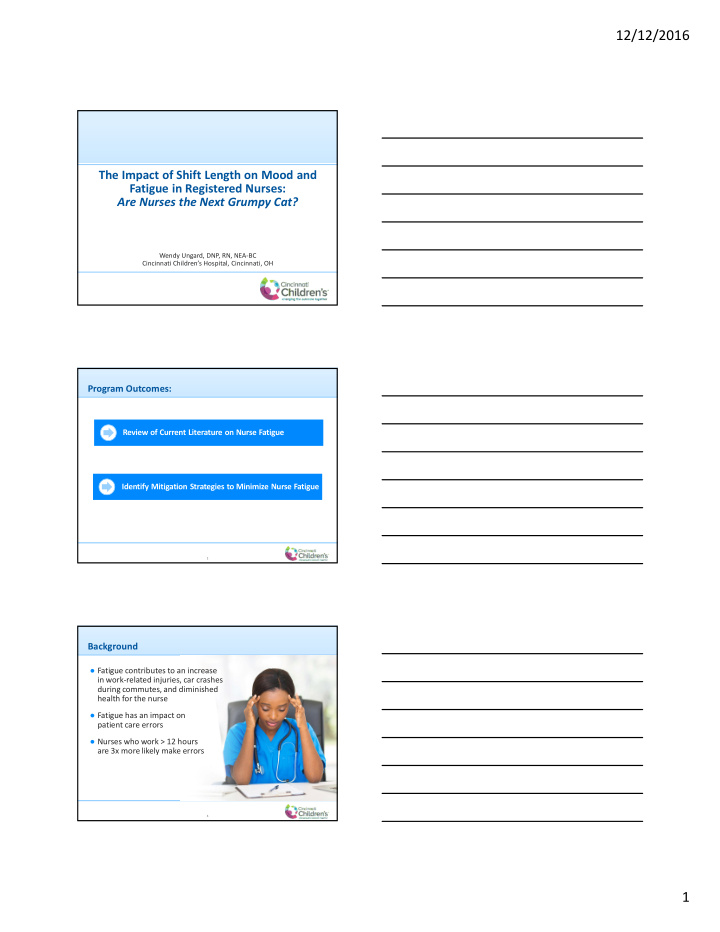



12/12/2016 The Impact of Shift Length on Mood and Fatigue in Registered Nurses: Are Nurses the Next Grumpy Cat? Wendy Ungard, DNP, RN, NEA-BC Cincinnati Children’s Hospital, Cincinnati, OH Program Outcomes: Review of Current Literature on Nurse Fatigue Identify Mitigation Strategies to Minimize Nurse Fatigue 2 Background � Fatigue contributes to an increase in work-related injuries, car crashes during commutes, and diminished health for the nurse � Fatigue has an impact on patient care errors � Nurses who work > 12 hours are 3x more likely make errors 3 1
12/12/2016 Background (continued) IOM published findings that TJC issued Sentinel Event Alert stated extended work hours regarding nurse fatigue and and insufficient sleep can patient safety lead to patient errors 4 Background (continued) � Nurse fatigue can occur due to demands of physical work, long hours and persistent thoughts of work � This study supports current literature related to nurse fatigue and provides additional data demonstrating the impact of shift length on mood and fatigue 5 Problem Statement � The goal of this study was to determine baseline sleep, physical activity, and work hours, and relate these to the fatigue and mood states of registered nurses working 8-hour and 12-hour shifts 6 2
12/12/2016 Methods � Sample � Recruitment � Inclusion/Exclusion � Surveys � Analysis of data 7 Measures and Analysis: Research Questions � How do nurses working 8-hour shifts compare to 12-hour shifts on physical activity (steps per day), sleep quality, body mass index, work immersion and social support? � How well do the factors of physical demands, work immersion, social support and sleep quality predict chronic fatigue, acute fatigue, inter-shift recovery and mood in RN’s working 8 or 12 hour shifts? � Is there a difference among shifts for fatigue, inter-shift recovery and mood state? 8 Measures and Analysis (continued) � SPSS 22.0 � Descriptive statistics � Independent Sample t-test � Multiple Regression � Analysis of Variance (ANOVA) and Multiple Analysis of Variance (MANOVA) � Significance level was p<0.05 9 3
12/12/2016 Results � 97% of RNs reported their workload to be heavy or extremely heavy � No difference in steps, work immersion, social support, or BMI for nurses working either an 8 or 12-hour shift � There was a difference in sleep quality and age 10 Results (continued) � 4 Multiple regression analyses conducted to predict chronic fatigue, acute fatigue, inter-shift recovery and mood � Independent Variable = work immersion, sleep quality, social support and average daily steps � Higher work immersion and lower sleep quality, but not average daily steps predicted chronic fatigue 11 Results (continued) � Higher work immersion was a significant predictor for acute fatigue. Physical activity, sleep quality and social support were not � None of the IV predicted inter-shift recovery � MANOVA was conducted to determine effect of shift length on chronic and acute fatigue, inter-shift recovery and mood state � Less inter-shift recovery for the 12-hour shift RNs. No difference for mood, chronic, or acute fatigue. 12 4
12/12/2016 Table 1 Demographic Characteristics for Registered Nurses Working 12-hour Day and Night Shifts and 8-hour Day and Evening Shifts Shift Type Mean SD N 12-hr AM 31.26 3.856 19 12-hr PM 29.41 6.672 20 Age 8-hr Day 43.11 11.448 18 8-hr Evening 30.33 7.129 18 12-hr AM 36.25 6.79 19 12-hr PM 26.85 6.35 20 BMI 8-hr Day 28.55 7.27 18 8-hr Evening 27.31 4.91 18 13 Pearson Correlations (r) for Independent Variables OFER-C OFER-A OFER-R POMS .017 .156 .031 .096 Avg. Steps (.442) (.088) (.393) (.203) Sleep .262** .116 .188** .228** Quality (.011) (.158) (.051) (.023) Work .444** .338** .295** .158 Immersion (.000) (.001) (.005) (.084) Social .251** .120 .136 .001 Support (.014) (.150) (.120) (.498) * p =<0.05 ** p =<0.01 14 Table 2. Mean and SD of Fatigue and Mood Scores for RN’s Working 12-hour Day (A) and Night Shifts (P) and 8-hour Day and Evening Shifts Shift Type Mean SD N 12-hr, AM 41.83 22.97 20 8-hr, Days 49.12 19.27 19 OFER Chronic 8-hr, Evenings 35.83 26.55 20 12-hr, PM 43.83 23.47 20 12-hr, AM 54.83 12.90 20 8-hr, Days 49.82 17.44 19 OFER Acute 8-hr, Evenings 48.33 17.08 20 12-hr, PM 51.33 9.13 20 12-hr, AM 44.00 15.16 20 8-hr, Days 36.84 15.92 19 OFER Recover 8-hr, Evenings 33.83 18.23 20 12-hr, PM 48.66 8.67 20 12-hr, AM 0.08 9.32 20 8-hr, Days 2.41 8.17 19 Total POMS Avg. 8-hr, Evenings 7.58 10.71 20 12-hr, PM 4.27 8.86 20 15 5
12/12/2016 Mean Mood State by Shift POMS Mood Score 7.6 8 7 6 5 4.3 4 3 2.4 2 0.9 1 0 8 Hour Day 12 Hour Day 8 Hour Evening 12 Hour Night 16 Discussion � Difference in age and sleep quality. Why? � Social support, higher work immersion, and lower sleep quality predict chronic fatigue. Why? � Higher work immersion predicted acute fatigue. Why? � Less inter-shift recovery for 8-hour vs 12-hour. Why? 17 Other Considerations � The research is mixed regarding whether shift lengths and physical fatigue do seem to influence care � While this study speaks to physical fatigue, another type of fatigue, compassion fatigue may also be a factor in metrics such as safety, quality of care and patient and employee satisfaction 18 6
12/12/2016 Questions 19 7

Recommend
More recommend